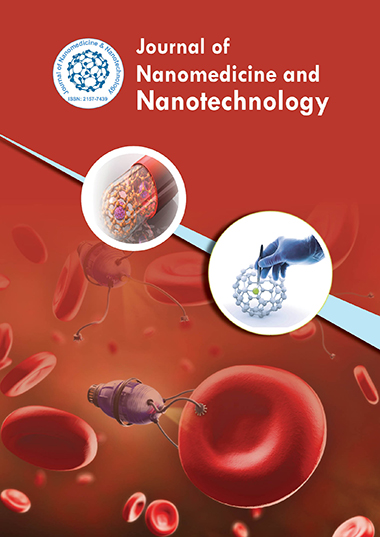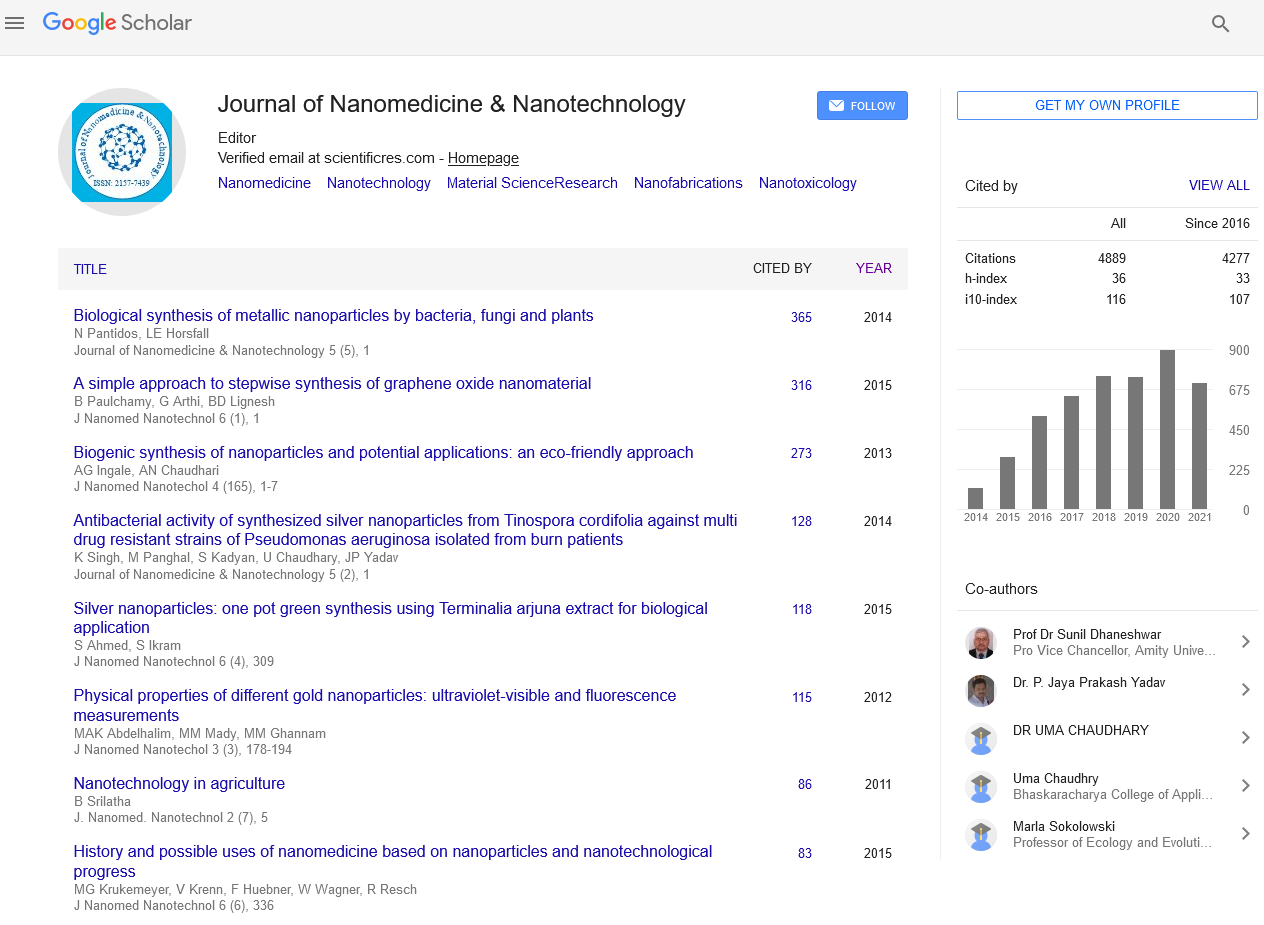Indexed In
- Open J Gate
- Genamics JournalSeek
- Academic Keys
- JournalTOCs
- ResearchBible
- China National Knowledge Infrastructure (CNKI)
- Scimago
- Ulrich's Periodicals Directory
- Electronic Journals Library
- RefSeek
- Hamdard University
- EBSCO A-Z
- OCLC- WorldCat
- SWB online catalog
- Virtual Library of Biology (vifabio)
- Publons
- MIAR
- Scientific Indexing Services (SIS)
- Euro Pub
- Google Scholar
Useful Links
Share This Page
Journal Flyer

Open Access Journals
- Agri and Aquaculture
- Biochemistry
- Bioinformatics & Systems Biology
- Business & Management
- Chemistry
- Clinical Sciences
- Engineering
- Food & Nutrition
- General Science
- Genetics & Molecular Biology
- Immunology & Microbiology
- Medical Sciences
- Neuroscience & Psychology
- Nursing & Health Care
- Pharmaceutical Sciences
Perspective - (2025) Volume 16, Issue 2
Nanoparticles for Next-Generation Sensors and Smart Devices
Kjell Osterberg*Received: 01-Mar-2025, Manuscript No. jnmnt-25-28609; Editor assigned: 05-Mar-2025, Pre QC No. jnmnt-25-28609; Reviewed: 20-Mar-2025, QC No. jnmnt-25-28609; Revised: 25-Mar-2025, Manuscript No. jnmnt-25-28609; Published: 31-Mar-2025
Abstract
Nanoparticles have emerged as key enablers in the development of next-generation sensors and smart devices, offering enhanced sensitivity, miniaturization, and multifunctionality. Their unique physicochemical properties, such as high surface area, tunable optical behavior, and electrical conductivity, allow for improved detection capabilities in biosensors, environmental monitoring, and wearable technology. With applications spanning healthcare, security, and industrial automation, nanoparticles are driving innovations in smart systems. However, challenges such as biocompatibility, stability, and large-scale manufacturing must be addressed to fully harness their potential. This article explores the role of nanoparticles in advanced sensing and smart device technology, discussing their benefits, challenges, and future prospects
Keywords
Nanoparticles; Sensors; Smart devices; Nanotechnology; Biosensors; Wearable electronics; Environmental monitoring; Optical sensors; Conductive nanomaterials; Smart systems
INTRODUCTION
The rapid advancement of sensor technology and smart devices has been largely driven by the integration of nanotechnology, particularly nanoparticles. These tiny materials, typically measuring less than 100 nanometers, exhibit unique properties that significantly enhance the performance of sensing and electronic devices. As industries demand more efficient, accurate, and compact solutions, nanoparticles have become essential in revolutionizing biosensors, wearable technology, and industrial automation. Their ability to enhance signal transduction, improve sensitivity, and enable real-time monitoring is paving the way for smarter and more responsive systems. This article delves into the various types of nanoparticles used in sensor technology, their applications, and the challenges they present [1,2].
DESCRIPTION
Nanoparticles contribute to sensing and smart devices in various ways, depending on their composition and function. Commonly used nanoparticles include [3].
Metallic nanoparticles (Gold, Silver, Platinum): These nanoparticles exhibit excellent conductivity and plasmonic properties, making them ideal for optical and electrochemical sensors used in medical diagnostics and environmental monitoring.
Semiconductor nanoparticles (Quantum Dots, Titanium Dioxide): Known for their tunable optical properties, these nanoparticles enhance photodetectors, light-emitting sensors, and next-generation display technologies.
Carbon-based nanomaterials (Graphene, Carbon Nanotubes, Fullerenes): These materials provide high electrical conductivity and mechanical strength, supporting flexible electronics and advanced wearable sensors.
Polymeric nanoparticles: Offering biocompatibility and controlled drug release properties, these nanoparticles play a crucial role in smart medical sensors and therapeutic devices [4,5].
Nanoparticles enable enhanced performance in sensors by increasing detection accuracy, reducing energy consumption, and enabling real-time data collection. Their incorporation into wearable electronics, healthcare monitoring devices, and industrial sensors demonstrates their versatility in modern technology [6].
DISCUSSION
The adoption of nanoparticles in sensor technology brings several advantages:
Enhanced sensitivity and selectivity: Nanoparticles amplify signals, allowing for highly sensitive detection of biomolecules, gases, and environmental pollutants.
Miniaturization and portability: Their nanoscale dimensions enable the development of compact, portable, and wearable sensors for continuous monitoring applications [7,8].
Real-time monitoring and smart integration: With the ability to respond rapidly to stimuli, nanoparticle-based sensors facilitate real-time data acquisition, crucial for healthcare and industrial automation.
Multifunctionality: Nanoparticles can be tailored for dual-function applications, such as combined sensing and therapeutic delivery in biomedical devices [9].
Despite these benefits, there are challenges to address.
Biocompatibility and toxicity: Some nanoparticles pose health risks, necessitating extensive studies on their safe use in medical and wearable applications [10].
Stability and degradation: Ensuring long-term stability and preventing nanoparticle aggregation are essential for reliable sensor performance.
Scalability and cost: The large-scale production of high-quality nanoparticles remains expensive and complex, limiting widespread commercial adoption.
Addressing these challenges requires interdisciplinary collaboration among scientists, engineers, and regulatory bodies to ensure safe and efficient implementation of nanoparticle-based technologies.
CONCLUSION
Nanoparticles have revolutionized sensor technology and smart devices by offering unprecedented sensitivity, miniaturization, and multifunctionality. Their integration into biosensors, environmental monitoring systems, and wearable electronics demonstrates their transformative potential. While challenges related to safety, stability, and scalability persist, ongoing research and innovation continue to drive advancements in this field. As nanoparticle-based sensors become more refined and accessible, they will play a pivotal role in shaping the future of intelligent and responsive technologies across various industries.
ACKNOWLEDGEMENT
None
CONFLICT OF INTEREST
None
REFERENCES
- Jones LW, Anderson T. Exercise Oncology: Historical Perspective and Future Directions. Cold Spring Harb Perspect Med. 2023;13(6): a037038.
- Lee JH, Wilson W. Virus-Mimicking Phytosomes for Drug Delivery in Cancer. Pharmaceutics. 2020; 12(3): 229.
- White KA, Parker N. Expanding the Scope of Enzyme Specificity for Genome Engineering. J Am Chem Soc. 2021; 143(45):18445-18450.
- Garcia JR, Wilson W. RNA Delivery and Therapeutics for Oncology. Trends Pharmacol Sci. 2021; 42(11): 905-915.
- Kamaly N, Yameen B, Wu J. Degradable Controlled-Release Polymers and Polymeric Nanoparticles: Mechanisms of Controlling Drug Release. Chemical Reviews. 2016; 116(4): 2602-2663.
- Lee K, Anderson R. Nanoparticles in Biology and Medicine: Small Structures with Big Potential. Adv healthc mater. 2022; 11(19): 2100713.
- Harrison OJ, Smith SJ, Sperandio M. Detection and Discrimination of Intact and Cleaved E-Cadherin Fragment Release from Cell Surfaces: Implications for Understanding the Role of E-Cadherin in Angiogenesis and Cancer Progression. J Proteome Res. 2023; 22(1): 683-693.
- Hoshyar N, Gray S, Han H. The effect of nanoparticle size on in vivo pharmacokinetics and cellular interaction. Nanoscale. 2016; 8(13): 6731-6747.
- Zhang S, Bellinger A, Genshaft A. A blood–brain barrier–penetrating gut-microbe-derived molecule that enhances amyloid beta deposition and cognitive impairment in a mouse model. Science Advances. 2021; 7(23): eabf1773.
- Tong R, Chiang HH, Kohane DS. Photoswitchable nanoparticles for in vivo cancer chemotherapy. Proc Natl Acad Sci. 2020; 110(46): 19048-19053.
Indexed at, Google Scholar, Crossref
Indexed at, Google Scholar, Crossref
Indexed at, Google Scholar, Crossref
Indexed at, Google Scholar, Crossref
Citation: Kjell O (2025) Nanoparticles for Next-Generation Sensors and Smart Devices. J Nanomed Nanotech. 16: 785.
Copyright: ©2025 Kjell O. This is an open-access article distributed under the terms of the Creative Commons Attribution License, which permits unrestricted use, distribution, and reproduction in any medium, provided the original author and source are credited.


